
Photo from wikipedia
Abstract In the field of machining fiber reinforced plastics (FRP) with defined cutting edges, there is still a high demand for research and development, especially, when various fiber types are… Click to show full abstract
Abstract In the field of machining fiber reinforced plastics (FRP) with defined cutting edges, there is still a high demand for research and development, especially, when various fiber types are embedded. Thus, when machining glass fiber reinforced plastics, the application of uncoated tools from tungsten carbide is often state of the art. This material is subject to excessive wear during machining FRP, which negatively affects the process performance and makes a regular tool change necessary. This is caused by a high abrasiveness of the fibers and by vibrations of the FRP components, which affects the cutting edge. One approach to reduce the process forces and therefore reduce tool wear is to superimpose the tool movement with a longitudinal high-frequency movement in ultrasonic range. Many studies showed that this technology is able to generate advantages in drilling and face milling processes. Primarily it reduces tool wear and improves machining quality. This study shows that positive effects also occur during peripheral milling of FRP, especially when using an unstable clamping. In this case, ultrasonic assistance can reduce the machining forces significantly. Additionally, it is shown that the shape and the state of wear of the cutting edge affects the impact of ultrasonic assistance in this application case.
Journal Title: Procedia Manufacturing
Year Published: 2019
Link to full text (if available)
Share on Social Media: Sign Up to like & get
recommendations!